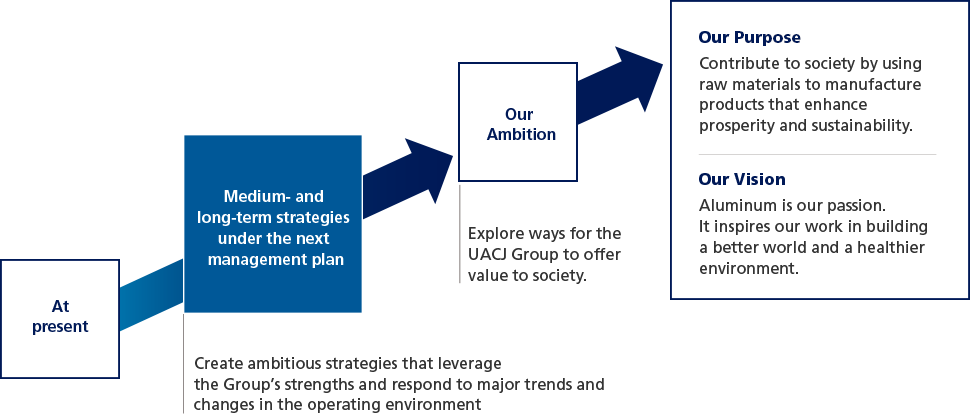The publication of this report comes at a time when the COVID-19 pandemic has caused serious hardships for people and businesses around the world. On behalf of the entire UACJ Group, I would like to express my sincere condolences to those who have lost loved ones due the coronavirus, and my deepest appreciation to the health care workers and other professionals on the front lines of this crisis. All of us are united in our commitment to the Group’s stakeholders in helping overcome the challenges they face under these difficult circumstances.
Targets unachieved for the second consecutive fiscal year due to dramatic changes in the market
UACJ Corporation (hereafter, “UACJ” or “the Company”) was founded in 2013 through the merger of two of Japan’s leading aluminum product manufacturers. Sharing the same long-term strategies and recognizing that the domestic market would contract in the future, the two companies aimed to grow sustainably as a global manufacturer by maximizing synergies through the merger to meet brisk demand in international markets, especially in Asia and North America. Accordingly, following the merger, UACJ carried out large scale investments to establish Tri-Arrows Aluminum Inc. in the United States and UACJ (Thailand) Co., Ltd., in Thailand, thereby creating a supply network extending beyond Japan to the rest of Asia and North America.
The Company made those growth investments because it could expect to generate enough profits in Japan for some time. Indeed, just after it formulated its investment plans, bottle-shaped aluminum cans came on the market, driving up domestic demand for canned coffee and other beverages. Meanwhile, automakers were increasingly using aluminum for body sheet as they strove to meet requirements for lighter vehicles. Demand for aluminum LNG tanks rose in line with growing shale gas exports from the United States. We also saw solid demand for aluminum thick plates used in liquid crystal and semiconductor manufacturing equipment.
While we had expected the Japanese market to contract, demand for aluminum was actually rising at that time in every market we supplied. Therefore, we held off on our plan to consolidate the Company’s domestic manufacturing plants, which we initiated under our previous mid-term management plan covering three years up to fiscal 2017, ended March 31, 2018. We also assumed domestic demand would grow when formulating our next management plan, spanning from fiscal 2018 to 2020, and stepped up investment in Tri-Arrows Aluminum and UACJ (Thailand) in order to tap brisk demand in Asia and North America.
From around the summer of 2018, however, China’s economy was slowing down and its trade war with the United States had started, causing major changes in the market both domestically and internationally. Reflecting those trends, domestic demand for aluminum thick plates fell sharply at a time when production facilities in the U.S. and Thailand, which we had expanded through substantial investment, had not reached the point of profitability. Consequently, the Company failed to achieve its financial targets for the second consecutive fiscal year. Consolidated financial results were down significantly year on year, with net sales decreasing by 7.0% to ¥615.1 billion, operating income falling by 31.9% to ¥10.1 billion, and ordinary income dropping by 38.9% to ¥3.8 billion. Net income attributable to owners of the parent was up, year on year, but that was mainly due to an increase in deferred tax assets.
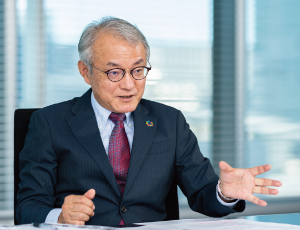
Shifts in UACJ’s business strategies
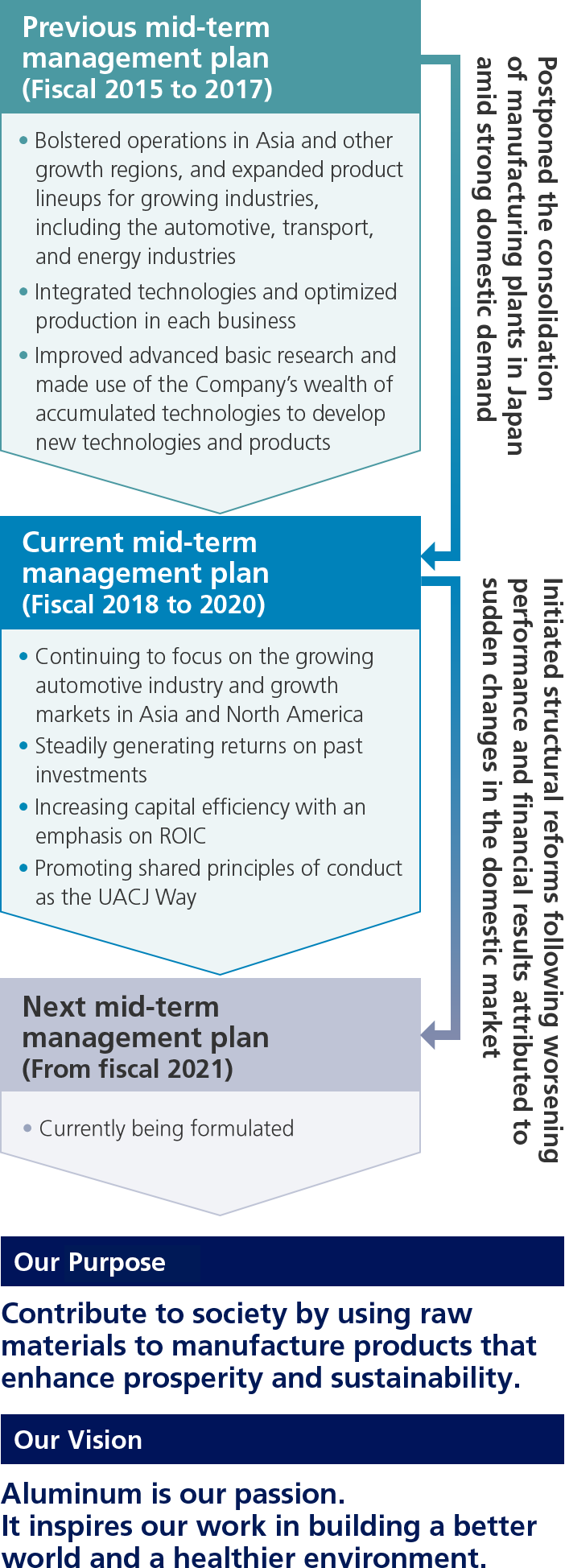
Implementing structural reforms based on three objectives for making a stronger group of companies
Aiming to overcome these severe circumstances, we began implementing a set of structural reforms in October 2019. That was quite early in comparison with other companies in Japan’s aluminum industry, but since the Company had already planned to restructure its domestic manufacturing operations as an urgent matter immediately after it was established in 2013, our response to changes in the operating environment was actually late in retrospect. We deeply regret having initiated the reforms only after financial results worsened.
We learned from recent circumstances that the Company’s earnings structure was unable to adapt to changes
in the operating environment and its financial structure was relatively weak. Furthermore, the Group’s slow response and inability to act decisively indicated a lack of leadership on the part of management. Therefore, to confront these issues head on and make the UACJ Group stronger, we designed the latest structural reforms based on the three objectives of increasing earnings capacity, reforming the financial structure, and increasing the speed and efficiency of management decision-making.
About one year has passed since we launched these reforms, and we are seeing progress towards each objective. With respect to increasing earnings capacity, consolidation of production facilities in Japan, which had been put off in the past, is now proceeding according to plan. In Thailand, new production facilities are fully operating following a third phase of capital investment, sales volume has increased, and favorable long-term contracts and agreements to revise prices with international customers have been concluded. In the U.S., Tri-Arrows Aluminum had to slightly delay the startup of a new cold-rolling mill due to the outbreak of COVID-19, but sales were unaffected and production capacity is being boosted incrementally.
As part of our efforts to reform the financial structure, we have been withdrawing from non-profitable and non-core businesses while narrowing the Company’s focus to its aluminum products businesses. Accordingly, the Company sold off its Wrought Copper Products business, which it had inherited from one of its founding companies. Meanwhile, all of the UACJ Group’s employees have been cooperating in urgent measures to cut costs. As a result of these efforts, the Company recorded positive free cash flow in fiscal 2019 for the first time since it was established in 2013.
Finally, to increase the speed and efficiency of management decision-making, we reorganized our management team to clearly separate management decision-making and execution as well as to clarify responsibilities and authority. Specifically, we reduced the number of executive officers from 27 to 14, as well as the number of full-time directors who concurrently serve as executive officers.
These structural reforms have been producing steady results so far, and the Company must complete this reform process in order to quickly improve financial results and get back on the growth track. At this time, we should have been implementing growth strategies under our current mid-term management plan, but we had no choice but to postpone those measures in order to focus on the structural reforms. Given the current circumstances, however, rather than just taking steps to improve short-term financial results, I believe we must take these steps to make the Group stronger and more capable of growing in the future.
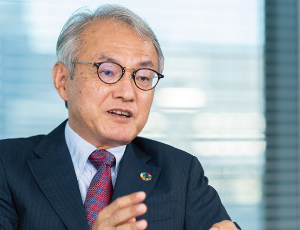
Objectives and targets of structural reforms
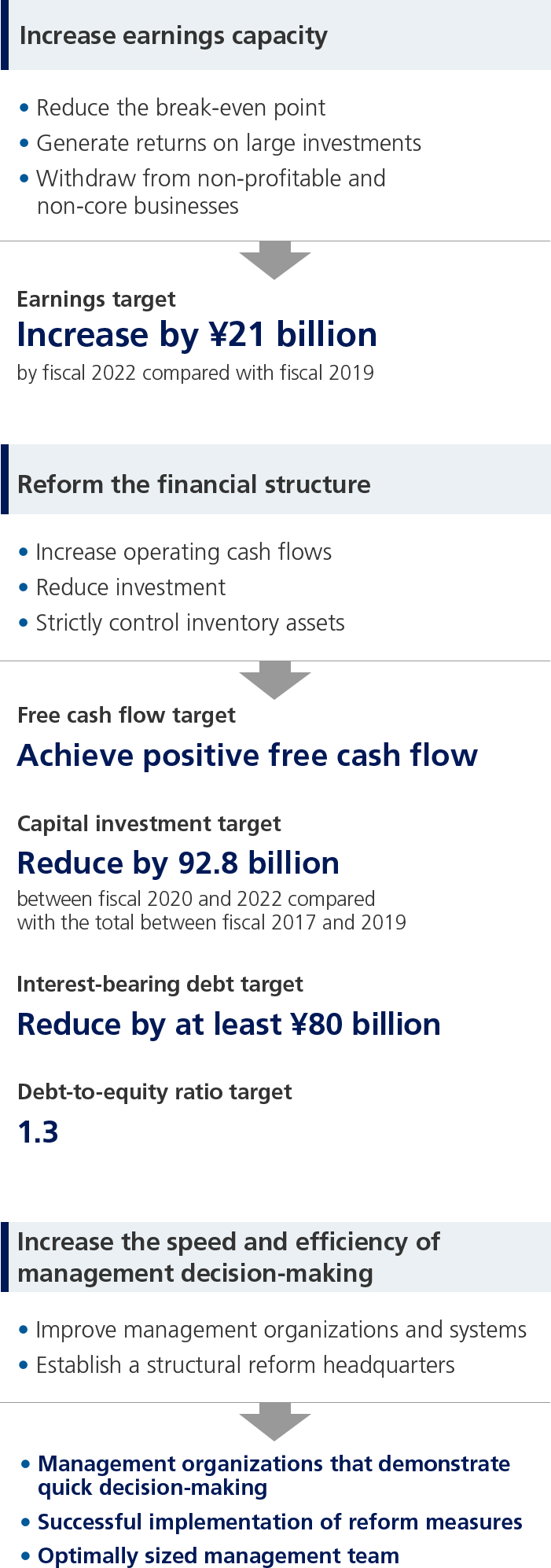
Creating new growth opportunities with a revised group philosophy
In fiscal 2019, while implementing structural reforms, we also revised our group philosophy. Comprised of Our Purpose, Our Vision, and Our Values, this philosophy broadly expresses the Group’s direction and lays a path toward the future we want to realize. Having reaffirmed this, all of us can share the same vision and harness our collective power when carrying out the structural reforms. During the revision process, we invited almost 400 employees and managers—ranging from young employees to senior managers—to share their ideas in order to reflect the views and aspiration of all members of the Group.
Looking at this new philosophy now, I believe it has been put into practice through the prior investments and other measures we implemented in past years. Through capital investment in Tri-Arrows Aluminum and UACJ (Thailand), we provided customers around the world with aluminum products that help reduce environmental impacts, realizing our mission of contributing to society by enhancing prosperity and sustainability. Through the Company’s acquisition of UACJ Automotive Whitehall Industries, Inc., we improved our ability to offer solutions in the auto industry. We also established new R&D facilities in Thailand and the United States, which are working to maximize the potential of aluminum and help lower environmental loads across a wide range of industries.
Using the new corporate philosophy as a starting point, the UACJ Group will seek to create new growth opportunities going forward. Harsh business conditions will continue in many industries due to the COVID-19 pandemic, but some industries have actually experienced even faster growth, such as IT services and healthcare. Various aluminum products are needed in those industries, including magnetic discs and substrates for cloud servers, IT-related equipment components, and radiation-related components for medical equipment. Therefore, we intend to expand businesses that can take advantage of these opportunities for growth.
When pursuing such opportunities, however, we must always consider how the UACJ Group can offer value to society. Manufacturers of aluminum and other metal products provide value to society by supplying their customers with materials they need to use. For the Group to continue enhancing the value it provides in the future, however, besides ensuring a stable supply of aluminum products to its customers, it must also offer useful and innovative new solutions. More than ever before, we need to develop new applications for aluminum and demonstrate how its benefits cannot be matched by other materials.
This means that we must shift from being a group of companies that simply supplies aluminum products to being an enterprise that helps customers and communities innovate by providing valuable solutions. Aluminum is regarded as a technologically advanced material, but since it is so widely used throughout society, it still has a great deal of potential as a material with respect to its applications, properties, and machining technologies.
Even today, however, some people say that machining aluminum is difficult. It is true that machining aluminum is not as easy as other metals like iron, but I think that weak point can actually drive business opportunities. UACJ’s two founding companies had been developing and manufacturing aluminum products for over a century, so we have more experience and expertise than any other manufacturer—that is UACJ’s biggest strength. By leveraging the Company’s accumulated technologies and know-how to improve and refine the machinability of aluminum parts and components, we can solve the technical limitations of machining aluminum and, therefore, create new demand for applications that were previously unfeasible.
While overcoming this weak point, our solutions must also more effectively leverage aluminum’s strong points, including its light weight, electrical and thermal conductivity, and excellent recyclability. Aluminum is already being used in the auto industry for body sheet and structural components, thereby helping reduce environmental impacts by facilitating material recycling and reducing vehicle weight, which improves mileage. Against that backdrop, the Company established its Mobility Technology Center to lead the development of new auto parts and components. This center will be at the forefront of the Group’s efforts to accelerate the development of solutions in the growing automobile market. It will also enhance the Group’s ability to offer solutions in other markets, while making the most of aluminum’s strengths. In these ways, we will work to lower environmental burdens and help make a more sustainable and prosperous society.
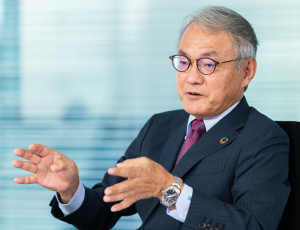
Creating the next mid-term management plan with a longer-term strategic outlook
Anticipating steady progress through our structural reforms, which are now proceeding in earnest across the entire UACJ Group, we will design the next management plan to realize future growth, giving consideration to strategies from an even longer-term perspective than before. That is because the aluminum manufacturing industry is a very capital-intensive industry, so it is not uncommon for large-scale investments to require five or six years from the time of planning and carrying out the investment until facilities start operating and generate profits. Therefore, instead of thinking in terms of three-year management plans, we will consider growth strategies spanning over five to ten years, and position the next management plan within that timeframe.
The next ten years will bring us to 2030, the final year for achieving the United Nations’ Sustainable Development Goals (SDGs), which are comprised of 17 goals and 169 targets. With that in mind, one approach we are considering is to specify the UACJ Group’s ambitions for 2030 based on the SDG targets it is focusing on, and establish the next mid-term management plan as the first step towards realizing those ambitions. If we take this approach, the starting point for the whole plan will be the UACJ Group’s purpose statement that we revised in February 2020: “To contribute to society by using raw materials to manufacture products that enhance prosperity and sustainability.” Guided by this new purpose, we will fully examine what the Group can do over the next decade, set qualitative and quantitative goals based on sustainability criteria, including the SDGs, and devise measures for achieving those goals.
Two of the Group’s key competitive advantages are particularly relevant for executing such medium- and
long-term growth strategies—its ability to provide solutions derived from extensive expertise in aluminum, and its global supply network based in Japan, the United States, and Thailand. We can leverage this supply network to flexibly respond to surges in market demand in North America, Asia, or other regions of the world. For example, when demand for aluminum can stock outpaces supply in North America, the Group’s production facilities in Japan and Thailand can help those in the U.S. to fill growing orders. In other words, the Group can ensure a stable supply as only a global manufacturer can. Furthermore, taking advantage of the Group’s solid track record in Japan, the Company’s subsidiaries in the U.S. can supply materials and components to Japanese automobile and parts manufacturers that have set up operations in North America. The adoption of aluminum for automotive body sheet and structural components is expected to quickly pick up pace in Asia in the future now that automakers have done so in the U.S., Europe, and Japan. Utilizing its operations in Thailand, the Group’s supply network will be able to make a smooth transition to supplying those products in Asia by drawing from the accomplishments and know-how it has built up in the U.S. and Japan.
While making the most of the Group’s competitive advantages—its solutions capabilities and global supply network—we intend to aggressively promote new markets for aluminum products by responding flexibly to the changing needs of customers and society in general under our next mid-term management plan.
Aluminum is an essential material for modern society. In fact, at a time when many factories in North America suspended operations due to the spread of COVID-19 from the spring of this year, the aluminum industry was designated by governments as an essential industry, allowing operations to go ahead. Guided by our new corporate philosophy, all of our employees are determined and committed to taking on new challenges so that the UACJ Group can continue fulfilling its social responsibility as an aluminum product manufacturer. As we pursue these endeavors, we ask for the ongoing support of the Group’s many stakeholders around the world.
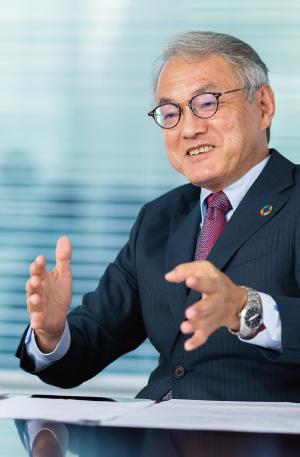
Envisioning the way forward under the next management plan
